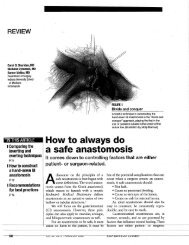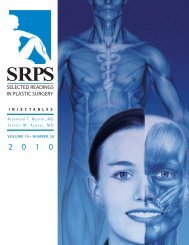SRPS PS - Plastic Surgery Internal
SRPS PS - Plastic Surgery Internal
SRPS PS - Plastic Surgery Internal
Create successful ePaper yourself
Turn your PDF publications into a flip-book with our unique Google optimized e-Paper software.
<strong>SR<strong>PS</strong></strong> Volume 10, Issue 25, 2009<br />
antibiotics can expose the patient to unnecessary side<br />
effects and complications and can promote the<br />
development of resistant strains.<br />
Infections with Streptococcus species present<br />
rapidly, with marked cellulitis and possibly<br />
lymphangitis. Although an antistaphylococcal<br />
penicillin or first-generation cephalosporin adequately<br />
cover S. aureus, streptococci are better covered by<br />
penicillin. Gram-negative infections might present with<br />
a cellulitis or purulent infection. Anaerobic bacteria are<br />
especially common in bite wounds, infections<br />
associated with intravenous drug abuse, and diabetics.<br />
In addition to the bacteria already mentioned, Eikenella<br />
corrodens is found in many human bite wounds 28–30 and<br />
Pasteurella multocida in many domestic animal bite<br />
wounds. 31–34 These usually are adequately covered by<br />
the addition of penicillin to an agent effective against<br />
the other gram-positive organisms. 35–37<br />
Compared with adults, children are more<br />
susceptible to unusual pathogens and have a higher<br />
incidence of oral flora, Pseudomonas aeruginosa, and<br />
Haemophilus influenzae 38,39 associated with infections.<br />
However, the associations probably are not frequent<br />
enough to warrant a change in the initial therapy for<br />
routine infections. Nevertheless, if suggested by gram<br />
stain, if a site of distant infection is present where the<br />
pathogens are common, or if the infection does not<br />
respond promptly to the standard antibiotics,<br />
additional coverage is warranted. The presence of<br />
multiple pathogens in hand infections is probably<br />
more common than is appreciated. 40<br />
If the patient is receiving recalcitrant to<br />
conventional antibiotic therapy, methicillin-resistant S.<br />
aureus (MRSA) must be considered. Cultures should be<br />
obtained, and an antibiotic that covers MRSA should<br />
be initiated. 27,41<br />
Prophylactic Antibiotics<br />
Three independent studies 42–44 showed that<br />
prophylactic antibiotics do not avert infection in cases<br />
of hand lacerations. Meticulous wound débridement<br />
and care are preferred over the routine use of<br />
antibiotics in cases of hand injuries. 45 Fitzgerald et al. 46<br />
recommend prophylactic antibiotics for hand wounds<br />
of home or industrial origin but not for farm wounds,<br />
which instead should undergo thorough débridement<br />
4<br />
and culture. Nylén and Carlsson 47 found no correlation<br />
between severity of infection and number of organisms<br />
present in wound or time elapsed before treatment (up<br />
to 18 hours) and further emphasized the importance of<br />
wound débridement in the care of hand injuries.<br />
Prophylactic antibiotics do have a role in cases<br />
undergoing the following procedures: 1) soft-tissue<br />
reconstructive procedures with large flaps, 2) total elbow<br />
or wrist implant arthroplasty, 3) procedures of long<br />
duration, 4) complex open hand trauma with wound<br />
contamination and extensive soft-tissue and bony injury,<br />
and 5) procedures longer than 2 hours in duration. 45<br />
For routine surgical cases in which more than 2<br />
hours of time elapses and prophylactic antibiotics are<br />
recommended, the choice of antibiotic typically is a<br />
first-generation cephalosporin. This typically is<br />
administered as cephalexin four times a day, but new<br />
evidence shows that administering the same total<br />
dosage in two doses is equally effective. 48 The duration<br />
of the administration of the antibiotics is unclear, but<br />
the literature does show that if the time period exceeds<br />
4 days, the antimicrobial resistance is altered. 49<br />
Management<br />
Although the spectrum of acute bacterial hand<br />
infections is broad, the management principles are<br />
similar for all and can be summarized as follows:<br />
rest, elevation, and immobilization in position of<br />
function<br />
adequate drainage of all loculations of pus and<br />
débridement of necrotic tissue<br />
antibiotics, determined by sensitivities from<br />
aerobic and anaerobic cultures (obtained before<br />
commencement of antimicrobial therapy) and<br />
special cultures—fungi, mycobacteria, viruses—<br />
as indicated<br />
treatment with broad-spectrum antibiotics that<br />
cover for MRSA<br />
tetanus prophylaxis for all penetrating wounds<br />
early, aggressive hand therapy<br />
Common Bacterial Infections<br />
Hand infections can be acute or chronic, but the<br />
overwhelming majority are acute. Of the acute<br />
infections, more than 90% are caused by<br />
bacterial pathogens. 20






